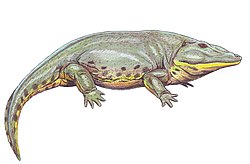Eryops
Eryops [1] is a genus of extinct, semi-aquatic temnospondyl.
| Eryops | |
|---|---|

| |
| Eryops: National Museum of Natural History, Washington DC | |
| Scientific classification | |
| Kingdom: | Animalia |
| Phylum: | Chordata |
| Order: | Temnospondyli |
| Family: | Eryopidae |
| Genus: | Eryops Cope, 1887 |
| Species: | E. megacephalus
|
| Binomial name | |
| Eryops megacephalus Cope, 1877
| |
They are found mostly in the Lower Permian-aged (about 295 million years ago) red beds of Texas. Fossils are also found in New Mexico and parts of the eastern United States. Eryops also occurs in older Pennsylvanian strata of the Conemaugh Group in West Virginia.[2]
Eryops averaged a little over 1.5-2.0 meters (5–6.5 ft) long, so it was one of the largest land animals of its time. It weighed about 90 kilograms (200 lb). It probably had few predators, although the apex predator of the time was the synapsid Dimetrodon, which was even larger. Several complete skeletons of Eryops have been found in the Lower Permian, but skull bones and teeth are the most common fossils.
Eryops was better adapted to a terrestrial environment than its ancestors. Sturdy limbs and a strong spine supported the body while out of water.


